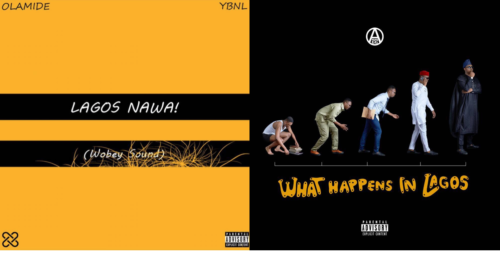Everywhere you turn in Lagos, there’s a story just waiting to be told. This year, two conceptual rap albums were released with the sole purpose of trying to tell them, albeit from two very different perspectives. Olamide – a man so revered by the streets that when he momentarily revoked Don Jazzy’s visa to the Mainland, you took the threat semi-seriously – reps for his constituents on his latest album, Lagos Nawa, while Ajebutter22 uses What Happens In Lagos, his sophomore project, to document the evolution of the upwardly mobile Lagosian.
Olamide is on a memorable run, 7 solo projects in 7 years is a rate of return only surpassed in Nigerian hip-hop by the super-prolific Mode Nine. But in whatever spare time he has left after recording so much music, Olamide must surely watch a ton of classic Nollywood movies. “Owo Blow”, off his prior album, referenced a popular Yoruba thriller, and in a similar vein, his new album was probably inspired by the Kehinde Soaga-directed classic, “Lagos Na Wah!!”.
https://www.youtube.com/watch?v=qHuAFarVJ4s
“Lagos Na Wah!!” was released in 1994; the movie put a comical twist on everyday life in the bustling city. In contrast, the inspiration behind Ajebutter22’s album title wasn’t homegrown. The MC instead shortened and repurposed the iconic Las Vegas tagline “What happens in Vegas stays in Vegas!” for domestic use. That tagline has historically been used as an excuse for visitors to Sin City to be on their worst behavior, however, on his new album, Ajebutter uses his unique style of conscious rap to expose some bad behavior in his own city.
One of the most endearing symbols of Lagos is the well-worn, yellow and black Danfo. Sadly, the state government plans to phase out the omnipresent buses next year with newer, not just Eko-friendly but also eco-friendly white and blue models. Whatever the future holds for the Danfo though, its iconic colors will probably live on as an emblem of the city. No album dedicated to Lagos would therefore be complete without referencing its famous mascot.
It is perhaps befitting that in the final year of the Danfo, two album covers were made that’ll memorialize the iconic vehicle. Ajebutter22 spells out the title of his album in Danfo yellow, set against a pitch black background. The album cover mimics the evolution of man to symbolize, what Butter sees as, the evolution of the Lagos big boy – from a struggling student to a full-blown, black agbada-wearing Yoruba demon. Olamide’s Lagos Nawa album cover, on the other hand, is far more minimalistic, it takes the two unmistakable colors from the side of the Danfo to the front of the album.

Having been released merely a week apart, both albums are available in Lagos traffic right now. Although, with Olamide being the bigger artist, you’d probably find far more vendors hawking his album than WHIL. But if you do go ahead to buy both albums, you might find that WHIL is a much better put-together project than Lagos Nawa.
With the exception of MI’s guest verse on “We Are Bad Boys”, which sounds like it was recorded over one of those NITEL payphones rotting away in the city, WHIL is a much more polished album. This is in sharp contrast to Lagos Nawa where Olamide continues to show that he has little appreciation for the technical side of music – like actually mixing and mastering songs properly. Also, whereas Ajebutter22 picked a theme and stuck to it conceptually, Olamide was only topically disciplined on a handful of songs, such as the album’s title track and the outstanding “Radio Lagos”.
Both Ajebutter22 and Olamide walk that fine line between rapping and singing in their music, so much so that calling their latest offerings ‘rap’ albums might actually be misleading. Butter mixes his innate hip-hop sensibilities with his characteristically deep-voiced, slightly off-key singing, while Olamide has all but invented his own subgenre: Wobey Sounds. At its core, the music is melodic, vibrant and danceable. It has strong ties to Lagos street culture. There are also subtle hints of Yoruba folk music, and on this particular album, Olamide sings two or three times more than he actually raps.
If I’m being honest, Ajebutter sounds so much more evolved in his chosen hip-hop fusion than Olamide. Whereas, with Young John exclusively producing Lagos Nawa, Wobey music sounds like it is still very much a work-in-progress, Butter sounds so comfortable in his lane that, on the few times he worked with producers other than his regular production team, Studio Magic, he still managed to retain his musical identity.
Ultimately though, the biggest difference between both projects isn’t really about the music itself, it’s more in who the music was made for and the almost antithetical types of Lagosians that both artists represent.
Olamide has a relatable grass-to-grace story and, in Lagos Nawa, he uses a more mainstream sound to use and tell it – he also unashamedly reps for the Ajepakos. Ajebutter22, on the other hand, is a rapper with a stage name that doesn’t even try to hide his upper middle-class privilege. He is one of the leaders of a group of artists fondly called ‘altè’ because of the niche their music caters to. WHIL continues where Anytime Soon, Butter’s debut album, stopped in telling his coming of age story, which – as hard as it may be to believe – isn’t always rosy.
Through their latest studio albums, Olamide and Ajebutter22 have both been able to paint yellow and black pictures of the same city; they just did it with brushes that couldn’t be any more different.
Originally written for Guardian Nigeria


